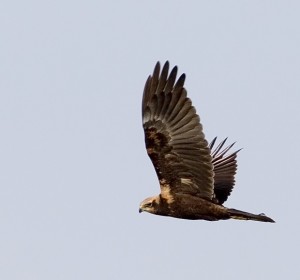Marsh Harriers
Marsh Harriers are more abundant and their status more secure than at any other time in the last century, with increased sightings occurring across Scotland and the rest of the UK, especially in the summer months.
The species declined greatly in the UK between the 19th and late 20th century due to persecution, habitat destruction via the draining of wetlands and excessive pesticide use, until the species was down to a single breeding female in 1971. Through changing attitudes towards birds of prey, the protection of wetlands and hard work by conservation organisations there are now around 360 breeding females in the UK. The species is, however, still classed as an Amber List species, due to their historical population decline and recovery over the past century.
The species can be seen in Scotland from April to October, after which they return to their Mediterranean breeding grounds, although some birds, mainly females, spend the whole year in Southern England. Here at Montrose Basin, sightings are fairly common over the summer months on the western side of the reserve.
Individuals can often be mistaken for Buzzards when in a particularly high soaring flight rendering its plumage details indistinguishable against a bright sky. However, Marsh Harriers tend to fly much lower than most birds of prey and flap gently between wavering glides, with their wings raised significantly. They are also slimmer and not as bulky as Buzzards, despite being the same size, and have longer tails and much lighter heads than Buzzards.

Marsh Harriers traditionally nest in large reedbeds, but since their population recovery they have began to colonise smaller reedbeds and arable fields, particularly those close to feeding areas. The female builds a nest from grass, reeds and small sticks on the ground amongst thick vegetation or in a crop. The male will also build several ‘false nests’ in the surrounding area to help confuse predators. 4-5 or sometimes up to 8 eggs are laid, hatching after 31-38 days. The chicks well then leave the next when around 35-40 days old, however the youngest often die when food is short and entire clutches can fail, succumbing to floods and predators.
Marsh Harriers usually hunt by gliding low over marshes and wetlands before dropping on to prey from the air, including small birds, chicks and ducklings and mammals including voles and rabbits. Marsh Harrier display flights are a spectacle to behold, with the males swooping and climbing high over the nesting territory before bringing food to the female. He then gives the female the food in a thrilling mid-air pass from foot to foot as she rolls beneath him. This display will continue as the male goes out to hunt for food for the chicks, calling the female from the nest each time he returns.
So next time you out for a leisurely summer stroll, be sure to look skywards for a chance sighting of these aerial acrobats.
Reserve Sightings Update
A Spotted Redshank in summer plumage has be seen at the slunks on both the 20th and 21st of June.
Ospreys have been spotted most days at low tide, with 3 seen at the one time on the 16th of June and 2 on the 19th.
Common Terns have settled on the nest in numbers of 30+ on numerous occasions but have unfortunately been driven off by two Carrion Crows who have been seen to take at least 3 eggs.
The first Eider ducklings were seen on the 1st of June and since then have increased across the reserve, with one crèche of 111 ducklings counted. The first Shelduck ducklings were seen in the 15th of June.
Craig Shepherd,
Visitor Centre Assistant Manager
Help protect Scotland’s wildlife
Our work to save Scotland’s wildlife is made possible thanks to the generosity of our members and supporters.
Join today from just £3 a month to help protect the species you love.
Preface
Marsh Harriers are more abundant and their status more secure than at any other time in the last century, with increased sightings occurring across Scotland and the rest of the …
